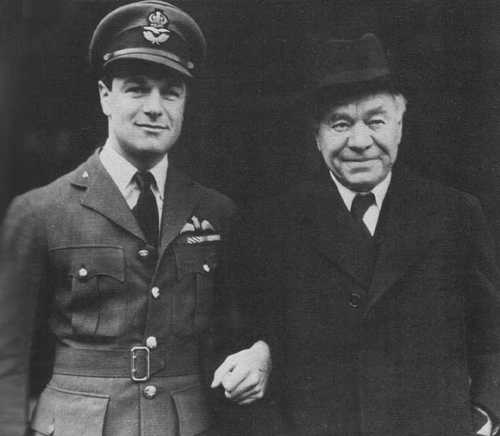
Canadian Forces
Canadians, Lord Beaverbrooke and his son Max Aiken
gsellars
Beaverbrook and Son Form Ideal Team Against Nazis Father Builds British War Planes While Youngster Demonstrates Right Methods of Flying Them - Wins Decoration For Heroic Exploit in Air London, Aug. 17, 1940 — Two men, father and son, are busily reducing the disparity between the British and German air forces. They are tackling the jobs from opposite ends; father builds British machines while son destroys the German ones. They are Lord Beaverbrook who, as minister of aircraft production, is devoting so much skill and energy to making Britain's air arm as formidable as possible, and his son, the Hon. Max Aitken, whose recent creditable performances in the air have won for him the Distinguished Flying Cross. Father knows how to produce the planes; son certainly knows how to fly them. Although Squadron-Leader Aitken has accounted for eight German planes and four more "possibles," the D.F.C. award has been made principally in recognition of one exploit, which is a rare procedure. The air ministry announced that, while leading a section of aircraft on patrol over Brussels, he displayed "great dash and gallantry." It was during this patrol that he attacked one of twelve Heinkel 111's, which was finally seen with one of its wings on fire and black smoke pouring from the other. While leading his section the following day, a large number of Heinkel 111 and Junkers 87 aircraft, escorted by Messerschmitt 110's were sighted. Squadron-Leader Aitken succeeded in destroying one Heinkel and one Junkers. Typical Exploit During a night in June, in difficult, circumstances, he destroyed yet another German aircraft. Now, let us take one typical exploit from this spectacular record. The attitude of Britain's flying men on defence work is distinctly Micawber-ish. For three uneventful nights young Max had sat in' his chair, dressed in his flying clothes and "Mac West"—as they call the yellow rubber life jackets, so colored to make them conspicuous in the water—"waiting for something to turn up:' The fourth night was cloudy and moonless. At 12 o'clock the operational phone rang and Max received orders to patrol a certain line. As he ran out to his fighting plane he could hear the sirens wailing in a nearby town. He was excited. The sudden, dramatic summons had broken the monotony of the previous three nights. He climbed to his ordered height and remained on his patrol line. An hour went by. Then came a wireless message, telling him the location of the Germans, who were flying from northwest to southeast. By a lucky chance he was proceeding in the right direction. Suddenly, all the searchlights which had been sweeping the night sky below him converged at a spot, throwing a brilliant luminous effect against a large cloud. Silhouetted against the cloud were three German aircraft flying across his starboard beam. Dead On Mark Max turned left and slowed down slightly. With a searchlight dead on it, one of the planes was immediately recognizable as a Heinkel 111. The two others disappeared, so Max fastened onto the remaining machine. He got about 100 yards behind and below the Nazi and, from this point, could clearly see his exhaust flanges. The German managed to evade the searchlight's beam and go into a dive. This rather threw out Max's calculations, for he was directly behind and above him. Getting back into the approximate position, he opened his hood to see better; then he adjusted his firing button and pressed it Bullets poured into the German, It was point-blank range. Max could see the tracer disappearing inside, but nothing seemed to happen except that the Nazi machine slowed down considerably. He almost overshot his mark, but managed to put his propeller into line and keep his position. Max let him have four more bursts. A glow appeared inside the machine, and, as they had been in a shallow dive and getting nearer the sea, Max fired the rest of his ammunition into him. The red glow increased; there could be no doubt that the Nazi was on fire. At 500 feet Max broke away to the right and tried to follow, but overshot, so he did not see the Heinkel strike the water. He climbed and released a parachute flare, which, as it fell toward the sea, revealed the Heinkel lying on the water, a column of smoke blowing from its rear section. Max circled over the scene a couple of times, but saw no movement. No one tried to climb out, so he turned and flew for home. Born in Montreal The alert and courageous young hero of these brilliant exploits was born in Montreal 30 years ago. Educated at Westminster and Pembroke college, Cambridge, he is a fine, all-round sportsman and an association football blue A mashie niblick (golf club -ed) or the wheel of a racing car are maneuvered with as little effort as he appears to require for handling a joystick. His professional career has been equally inspiring. Inheriting something of his father's drive, he can work 17 hours a day, in his journalistic and travel enterprises, without losing grip. Even before the war, he was recognized as one of Britain's best pilots. Flying one of Lord Beaverbrook's machines, he broke several transport plane records in America. An officer in the Auxiliary Air Force, he joined up at the outbreak of war and soon became an ace. He married last year.
2644 Views
12/28/2011
